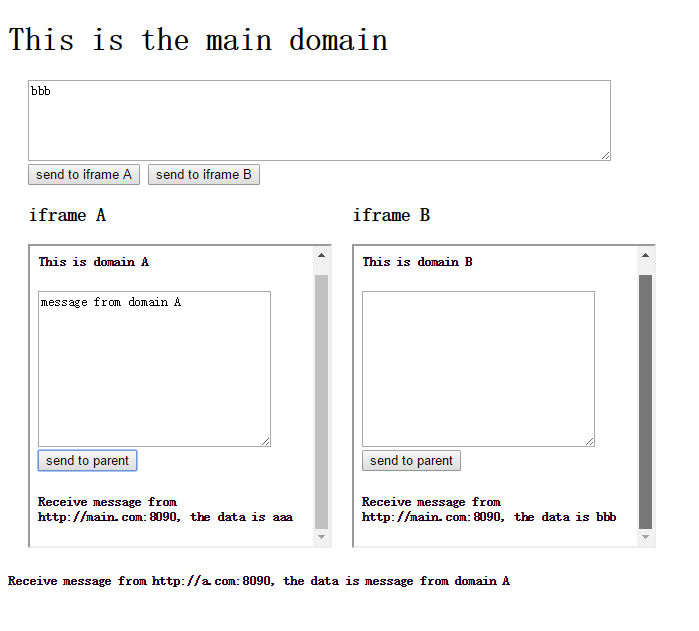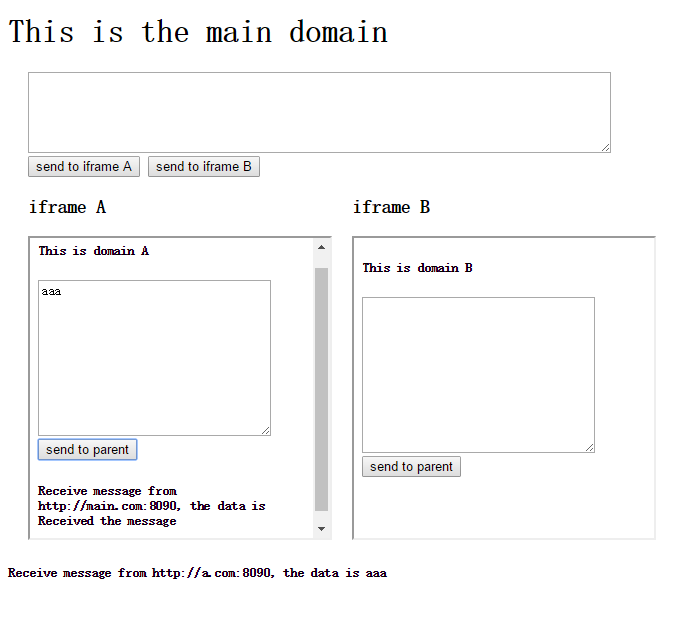本篇文章给大家带来的内容是关于HTML5中postMessage实现跨域的代码分析,有一定的参考价值,有需要的朋友可以参考一下,希望对你有所帮助。
对于使用H5实现跨域,很多人都一直处于半懂状态。知道使用postMessage发送消息,使用onMessage接受消息,但是到底哪个方法应该用window调用哪个应该用iframe的contentWindow调用不是很清楚。下面是我做的一个本地实现跨域的小demo,可以在github下载这个示例。为了执行它,首先,你需要找到你电脑的hosts文件,在127.0.0.1 localhost下添加如下代码:
127.0.0.1 localhost 127.0.0.1 main.com 127.0.0.1 A.com 127.0.0.1 B.com
然后,你需要启动一个服务器,如Apache等,把github上下载的三个html文件放到你的服务器上。最后,你只需访问http://main.com:你的端口号 ,就可以进行跨域通信了。
三个html文件的关系如下:三个域:http://main.com:8090 ; http://a.com:8090 ; http://b.com:8090 。 主页面maindomain.html在main.com,两个iframe (subAdomain.html , subBdomain.html)分别在 a.com , b.com 。在maindomain.html中,向textarea中输入消息,点击send to iframe按钮,可以发送消息到指定iframe (subAdomain.html 或者subBdomain.html),在ifame中也可以发送消息到maindomain.html,同时,有一个收到ifame消息的回执信息。
这应该是很常见的场景,把网站公共的资源放到某子域,在其他子域需要访问该子域上的资源。实现的效果如下。
1、不带回执信息: 
2、带回执信息: 
基本知识
首先介绍onMessage事件中,event的一些属性,理解这些可以使你很容易读懂我的示例。
* data: 传入的数据
* origin: 发送消息的文档所在的域
* source: 发送消息的文档的window对象的代理
如果你想在子域X向子域Y发送消息,你需要,在子域X的html文件,获取Y的window对象(iframe的contentWindow),然后调用postMessage(message,
Y所在的域),同时,在子域Y的html文件中,监听window对象message事件(使用onMessage)就好。当然,你可以在onMessage中再次使用postMessage,向子域X发送一个回执信息。 我们时常混乱的是,在哪个域的window对象上调用postMessage。
代码
main.com
<h1>This is the main domain</h1>
<div style="margin:0 20px;">
<textarea name="main" cols="80" rows="5"></textarea><br/>
<input type="button" value="send to iframe A"/>
<input type="button" value="send to iframe B"/>
</div>
<div style="float:left; margin:0 20px;">
<h3>iframe A</h3>
<iframe src="http://a.com:8090/subAdomain.html" frameborder="1" style="width:300px; height:300px;"></iframe>
</div>
<div style="float:left;">
<h3>iframe B</h3>
<iframe src="http://b.com:8090/subBdomain.html" frameborder="1" style="width:300px; height:300px;"></iframe>
</div>
<div style="float:left;">
<h5 id="received"></h5>
</div>
<script>
var received = document.querySelector('#received');
var sendToIframeA = document.querySelectorAll('input')[0];
var sendToIframeB = document.querySelectorAll('input')[1];
var iframeA = document.querySelectorAll('iframe')[0];
var iframeB = document.querySelectorAll('iframe')[1];
//receive message
function getMessage(e){
console.log('main received!');
received.innerHTML = 'Receive message from ' + e.origin + ', the data is ' + e.data;
e.source.postMessage('Received the message', e.origin);
}
window.addEventListener('message', getMessage, false);
//post message
sendToIframeA.addEventListener('click', function(){
var content = document.querySelector('textarea').value;
iframeA.contentWindow.postMessage(content, 'http://a.com:8090');
}, false);
sendToIframeB.addEventListener('click', function(){
var content = document.querySelector('textarea').value;
iframeB.contentWindow.postMessage(content, 'http://b.com:8090');
}, false);
</script>a.com
<h5>This is domain A</h5>
<textarea name="subA" cols="30" rows="10"></textarea>
<input type="button" value="send to parent"/>
<div style="float:left;">
<h5 id="received"></h5>
</div>
<script>
var send = document.querySelector('input');
var text = document.querySelector('textarea');
var received = document.querySelector('#received');
//receive message
function getMessage(e){
console.log('A received!');
received.innerHTML = 'Receive message from ' + e.origin + ', the data is ' + e.data;
//e.source.postMessage('Received the message', e.origin);
}
window.addEventListener('message', getMessage, false);
//post message
send.addEventListener('click', function(){
var content = text.value;
window.parent.postMessage(content, 'http://main.com:8090');
}, false);
</script>b.com
<h5>This is domain B</h5>
<textarea name="subB" cols="30" rows="10"></textarea>
<input type="button" value="send to parent"/>
<div style="float:left;">
<h5 id="received"></h5>
</div>
<script>
var send = document.querySelector('input');
var text = document.querySelector('textarea');
var received = document.querySelector('#received');
//receive message
function getMessage(e){
console.log('B received!');
received.innerHTML = 'Receive message from ' + e.origin + ', the data is ' + e.data;
//e.source.postMessage('Received the message', e.origin);
}
window.addEventListener('message', getMessage, false);
//post message
send.addEventListener('click', function(){
var content = text.value;
window.parent.postMessage(content, 'http://main.com:8090');
}, false);
</script>相关文章推荐:
以上是HTML5中postMessage实现跨域的代码分析的详细内容。更多信息请关注PHP中文网其他相关文章!
 H5:网络标准和技术的发展Apr 15, 2025 am 12:12 AM
H5:网络标准和技术的发展Apr 15, 2025 am 12:12 AMWeb标准和技术从HTML4、CSS2和简单的JavaScript演变至今,经历了显着的发展。 1)HTML5引入了Canvas、WebStorage等API,增强了Web应用的复杂性和互动性。 2)CSS3增加了动画和过渡功能,使页面效果更加丰富。 3)JavaScript通过Node.js和ES6的现代化语法,如箭头函数和类,提升了开发效率和代码可读性,这些变化推动了Web应用的性能优化和最佳实践的发展。
 H5是HTML5的速记吗?探索细节Apr 14, 2025 am 12:05 AM
H5是HTML5的速记吗?探索细节Apr 14, 2025 am 12:05 AMH5不仅仅是HTML5的简称,它代表了一个更广泛的现代网页开发技术生态:1.H5包括HTML5、CSS3、JavaScript及相关API和技术;2.它提供更丰富、互动、流畅的用户体验,能在多设备上无缝运行;3.使用H5技术栈可以创建响应式网页和复杂交互功能。
 H5和HTML5:网络开发中常用的术语Apr 13, 2025 am 12:01 AM
H5和HTML5:网络开发中常用的术语Apr 13, 2025 am 12:01 AMH5与HTML5指的是同一个东西,即HTML5。HTML5是HTML的第五个版本,带来了语义化标签、多媒体支持、画布与图形、离线存储与本地存储等新功能,提升了网页的表现力和交互性。
 H5指的是什么?探索上下文Apr 12, 2025 am 12:03 AM
H5指的是什么?探索上下文Apr 12, 2025 am 12:03 AMH5referstoHTML5,apivotaltechnologyinwebdevelopment.1)HTML5introducesnewelementsandAPIsforrich,dynamicwebapplications.2)Itsupportsmultimediawithoutplugins,enhancinguserexperienceacrossdevices.3)SemanticelementsimprovecontentstructureandSEO.4)H5'srespo
 H5:工具,框架和最佳实践Apr 11, 2025 am 12:11 AM
H5:工具,框架和最佳实践Apr 11, 2025 am 12:11 AMH5开发需要掌握的工具和框架包括Vue.js、React和Webpack。1.Vue.js适用于构建用户界面,支持组件化开发。2.React通过虚拟DOM优化页面渲染,适合复杂应用。3.Webpack用于模块打包,优化资源加载。
 HTML5的遗产:当前了解H5Apr 10, 2025 am 09:28 AM
HTML5的遗产:当前了解H5Apr 10, 2025 am 09:28 AMHTML5hassignificantlytransformedwebdevelopmentbyintroducingsemanticelements,enhancingmultimediasupport,andimprovingperformance.1)ItmadewebsitesmoreaccessibleandSEO-friendlywithsemanticelementslike,,and.2)HTML5introducednativeandtags,eliminatingthenee
 H5代码:可访问性和语义HTMLApr 09, 2025 am 12:05 AM
H5代码:可访问性和语义HTMLApr 09, 2025 am 12:05 AMH5通过语义化元素和ARIA属性提升网页的可访问性和SEO效果。1.使用、、等元素组织内容结构,提高SEO。2.ARIA属性如aria-label增强可访问性,辅助技术用户可顺利使用网页。
 H5与HTML5相同吗?Apr 08, 2025 am 12:16 AM
H5与HTML5相同吗?Apr 08, 2025 am 12:16 AM"h5"和"HTML5"在大多数情况下是相同的,但它们在某些特定场景下可能有不同的含义。1."HTML5"是W3C定义的标准,包含新标签和API。2."h5"通常是HTML5的简称,但在移动开发中可能指基于HTML5的框架。理解这些区别有助于在项目中准确使用这些术语。


热AI工具

Undresser.AI Undress
人工智能驱动的应用程序,用于创建逼真的裸体照片

AI Clothes Remover
用于从照片中去除衣服的在线人工智能工具。

Undress AI Tool
免费脱衣服图片

Clothoff.io
AI脱衣机

AI Hentai Generator
免费生成ai无尽的。

热门文章

热工具

适用于 Eclipse 的 SAP NetWeaver 服务器适配器
将Eclipse与SAP NetWeaver应用服务器集成。

SublimeText3 Mac版
神级代码编辑软件(SublimeText3)

Atom编辑器mac版下载
最流行的的开源编辑器

Dreamweaver CS6
视觉化网页开发工具

EditPlus 中文破解版
体积小,语法高亮,不支持代码提示功能





